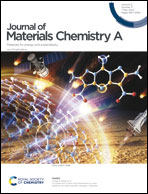Prussian blue analogue-derived high-entropy alloy nanoarchitectonics for efficient Fenton-like catalysis†
Abstract
The selective distribution of reactive oxygen species originating from the optimized activation of peroxymonosulfate (PMS) offers opportunities to achieve the effective elimination of contaminants in water, but the synergistic mechanism of this process is still unclear, especially the reaction intermediates on the multi-metal catalysts. Herein, we proposed a coordinate metal regulation strategy to modulate active sites by designing an FeCoMnNiCu Prussian blue analogue-derived high-entropy alloy system that possesses a 0D-1D hybrid nanoarchitectonic structure. The electronegativity differences between the metals induce significant variation in the coordination environment during pyrolysis, creating highly active Fe, Co, and Mn sites and secondary active Ni and Cu sites, thus enhancing interfacial electron transfer and reducing the adsorption energy of PMS activation. In situ Raman analysis and DFT calculations revealed that FeIV![[double bond, length as m-dash]](https://www.rsc.org/images/entities/char_e001.gif) O and ˙OH species were involved in the excitation process followed by the efficient elimination of various pollutants, which represents a breakthrough in the design of multi-metal Fenton-like catalysts for sustainable water decontamination.
O and ˙OH species were involved in the excitation process followed by the efficient elimination of various pollutants, which represents a breakthrough in the design of multi-metal Fenton-like catalysts for sustainable water decontamination.

- This article is part of the themed collection: Journal of Materials Chemistry A HOT Papers


 Please wait while we load your content...
Please wait while we load your content...